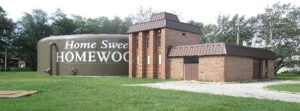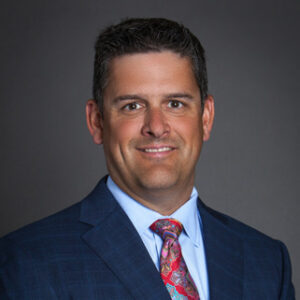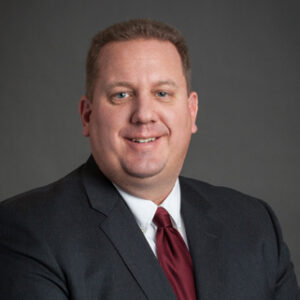The Village of Homewood, Illinois, recently decided to move forward with the biggest public works project it has undertaken since its founding in 1893. A 2½-mile stretch of 30‑inch transmission main and a booster pump station will allow it to change its water source from the Village of Harvey, Illinois, to the City of Chicago Heights, Illinois, allowing it to continue providing clean and reliable water service to its inhabitants at a lower and more reliable cost. The design-build firm Burns & McDonnell was selected to design and build the new tie-in. In this interview, Stephen Boden and Stephen Crede, respectively a senior project manager and a design and construction engineering department manager at Burns & McDonnell, tell Municipal Water Leader about how they are helping Homewood transition its water source on a tight timeline.
Municipal Water Leader: Please tell us about yourselves and how you came to be in your current positions.
Stephen Crede: This is my 22nd year in the industry. I was hired by Burns & McDonnell back at the beginning of 2007. I became a section manager in our water global practice, based in Chicago, in 2019, and I was promoted to department manager at the beginning of 2021.
Stephen Boden: I’ve been in the industry for 19 years, but I’ve only been with Burns & McDonnell for the last 20 months or so. I was with CDM Smith for the first 17 years of my career, traveling around the United States and doing projects in California, the Northeast, and the Midwest. I moved to Illinois about 8 years ago with my family. I support Burns & McDonnell’s water global practice, but I actually work on the firm’s construction design-build global practice in Chicago. My background is in construction, engineering, and installation. I take our plans on paper, go through value engineering, and then support construction and installation on site.
Municipal Water Leader: Please tell us about Burns & McDonnell as a company.
Stephen Crede: Burns & McDonnell was founded in 1898. It has been a 100 percent employee-owned company since 1986, and that characteristic really drives the culture here. We are headquartered in Kansas City, Missouri. We have more than 55 offices worldwide, including offices in Canada, India, Mexico, the Philippines, and the United Kingdom in addition to the United States. The company has over 7,600 employees and 9 different global practices—for instance, Stephen and I are focused on our water global practice, which includes any project that has a storm water, wastewater, or drinking water component. Burns & McDonnell has been in Fortune magazine’s 100 Best Places to Work list for more than 10 years—not just the company as a whole, but our individual regional offices as well. That’s something we take a lot of pride in.
Municipal Water Leader: Has water been a major piece of the company throughout its history, or is it new?
Stephen Crede: Water has been a part of the company from its beginning. Our first projects back in 1898 were water related. We are certainly not a new practice. All the practices at Burns & McDonnell are always looking to innovate, grow, and expand into new markets. The focus of the water practice is working to better serve the communities around us and the communities that we’re not currently in.

Stephen Boden: We want our water practice to become the design-build lead east of the Mississippi. That’s important to us.
Municipal Water Leader: What was the motivation behind the project that Burns & McDonnell worked on with the Village of Homewood?
Stephen Boden: The Village of Homewood wanted to switch its water source but still use water from Lake Michigan. It was worried about rate increases and rate uncertainty with its previous water provider. Its existing provider contract expires in 2022, so it saw an opportunity to make some changes and sign with a new provider.
The initial phase of the design involved determining how large a transmission main would be required to provide the necessary volume of water for the village and determining whether a booster pump station would be required to maintain the proper pressure within the transmission main. The determination was that the village needed to install a 30‑inch transmission main as well as a booster pump station.
Homewood decided on a design-build approach because it is planning to keep to an aggressive schedule according to which the new infrastructure must be designed, constructed, and started up by December 31, 2022. That may sound like a long time from now, but there are many steps in the process of changing water sources.
Municipal Water Leader: Where is this community located?
Stephen Boden: Homewood is approximately 30 miles south of downtown Chicago, near the Indiana-Illinois border. We are making our tie-in near the intersection of 183rd Street and Indiana Avenue by Thornton Quarry, which can be seen from I‑294.
Municipal Water Leader: Is the tie-in the only new piece of infrastructure that you are building for Homewood?
Stephen Boden: Yes; the tie-in itself is the project. It will involve 2½ miles of 30‑inch pipe and a booster pump station. The infrastructure that stores Homewood’s water and delivers it to its constituents is already in place.
Municipal Water Leader: How was Burns & McDonnell selected for this project?
Stephen Crede: Burns & McDonnell was one of several companies that was invited via a request for qualifications to submit on this project. We were excited about it and responded. Based on the statement of qualifications we submitted to the village, we were shortlisted. Then we and two other firms were invited to come in and interview. Ultimately, we believe what swayed the village to go with Burns & McDonnell was not just our team’s experience with transmission mains, but also our ability to perform the project as a design-build, which would help the village keep to its time frame.
Municipal Water Leader: Where are you in that time frame right now?
Stephen Boden: The project needs to be fully operational by December 31, 2022. Homewood’s contract with its current water provider expires on January 1, 2023. The design commenced in November 2019 and we are now getting into the beginning stages of construction and releasing materials.
Municipal Water Leader: Does weather have a major influence on this sort of construction?
Stephen Boden: The weather that we’re dealing with right now doesn’t affect our current work, but weather can pose problems for the hard installation of piping and for concrete work, affecting both the schedule and the costs. We are waiting for the snow to be gone and for warm weather to arrive; then, we can hit the ground running. That takes a lot of upfront preparation and planning, which is what we’re doing right now.
Municipal Water Leader: What are you changing to keep to this accelerated timeline?
Stephen Boden: The biggest thing that we changed in our overall approach to this project is that we started to engage permitting agencies a lot earlier than we normally would. We normally start to engage permitting agencies when the design process is about 90 percent complete, but for this project, we started to engage them early in the process, at 30 percent, so that we could obtain some of those permits earlier than usual. There are still some outstanding permits, but we should get them within the next month so that we can start construction in April.
Municipal Water Leader: Are any nonstandard permits necessary for this project?
Stephen Crede: The route we’re following for the transmission main goes through an old railroad right of way that was purchased by the village with this project in mind. Over time, the ditches that run along the old railroad bed have become wetlands. Part of our permitting deals with endangered species. For example, we can only take down trees during certain periods so that we do not affect the northern long-eared bat. We’ve taken those environmental considerations into account and have adjusted our schedule and design to accommodate them.
Municipal Water Leader: Have those concerns affected the way you are going to install the transmission pipe or the pump station?
Stephen Crede: Nothing with the booster pump station was affected by those factors, but they did influence our methods of installation and the materials we chose to go with.
Municipal Water Leader: What materials will you be using?
Stephen Crede: The transmission main is predominantly PVC for its entire 2½-mile length. The piping inside the booster pump station will be ductile iron. The standard lifespan of those materials is well over 100 years.
Municipal Water Leader: Please tell us about the corrosion control study you are doing for this project.
Stephen Boden: For the corrosion control study, we built corrosion skids, and working with the Village of Homewood, we harvested existing copper and lead service lines that were servicing constituent and citizen homes and installed them in racks so that we could see the effect, if any, that the new water source had on the pipes. The study started in October 2020 and will continue until we go into transition in 2022. We are doing this because there have been instances around the country in which a change in water sources has caused issues with water mains and service lines feeding homes. To avoid any problems of that nature, we are making sure that we meet and exceed the requirements of the Illinois Environmental Protection Agency. We worked closely with that agency to come up with a plan and a testing rig for the study and to implement it. So far, we’ve seen positive trends in our testing.
Municipal Water Leader: So the study observes the effects of the new water source on Homewood’s existing pipes, even though those pipes are not the focus of your current project?
Stephen Boden: The pipe we are installing is made of PVC, which is an industry norm and something that is used throughout the nation. A lot of the village’s underground transmission mains, however, are made of ductile iron, which is also resistant to corrosion. Our concerns about corrosion relate to lead pipes in the service lines. There was a pretty big lead issue in a different state; that’s what we’re trying to avoid.
Municipal Water Leader: Would a municipality like Homewood have concerns about the corrosion of lead pipes under normal circumstances, or do these concerns only arise in the case of a new water source?
Stephen Boden: If you keep the water chemistry the same, the effects on existing infrastructure are minimal or nonexistent, so the village would have never done a study like this if it were not changing water sources. Every municipality throughout the United States, including villages in Chicagoland like Homewood, has requirements for monitoring and testing the copper throughout its system for elevated lead samples.
Stephen Crede: As long as a village like Homewood was following its testing protocol without getting any results that would trigger an action level, there would be no reason for it to need to do a study like this under normal circumstances.
Municipal Water Leader: How did Burns & McDonnell help keep costs for Homewood at a minimum?
Stephen Crede: It was an iterative process. One of the things that we think is distinctive about how Burns & McDonnell approaches projects like this is that, starting early in the design process, we sat down with the village, walked through the different components of the project, and asked what its preferences were. We went to the 30 percent design level, which is more detailed than a conceptual layout but less than preliminary design, with that wish list from the village. That’s when Stephen Boden and our team of construction cost estimators estimated the real-world costs of the project. Then we went back to the village and walked through the design at 30 percent with the associated costs. The village and Burns & McDonnell were then able to work together to identify changes we could make to the design to save the village money while not diminishing the functionality of the system.

Municipal Water Leader: What changes will this project cause for the residents of Homewood?
Stephen Crede: In general, not much for the residents or the businesses should change. They’re still going to have Lake Michigan water, there will be no change in water pressure, and the water quality will be the same. The difference will be the cost certainty of the water rates that the village will be able to negotiate on their behalf.
Municipal Water Leader: Is there anything else you wanted to add?
Stephen Crede: There is a special culture at Burns & McDonnell. Stephen and I have both worked for other companies, but we have never found this kind of culture anywhere else. Our drive to give back to the communities where we live and work is second to none, whether it’s our commitment to science, technology, engineering and mathematics activities in education or our drive to increase diversity across the company and in our partnerships. These things are driving factors in how we do business. We are not just an engineering company; we are a company that is committed to making our clients successful and to making the communities where we live and work better.
Stephen Boden is a senior project manager in the Chicago construction/design-build group at Burns & McDonnell. He can be contacted at sboden@burnsmcd.com.

Stephen Crede is a design and construction engineering department manager in the Chicago water group at Burns & McDonnell. He can be contacted at screde@burnsmcd.com.

